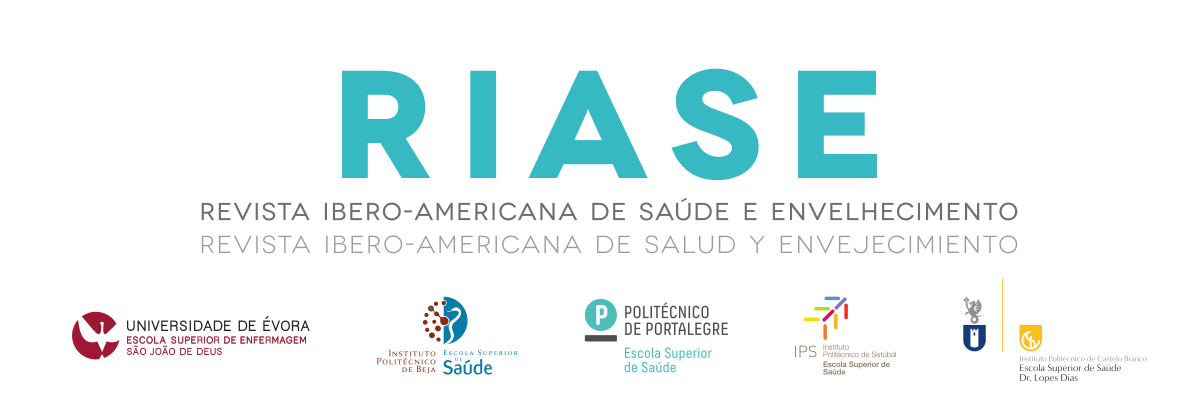TECNOLOGIAS DIGITAIS UTILIZADAS PARA PREVENÇÃO DE QUEDAS NO AMBIENTE HOSPITALAR: REVISÃO INTEGRATIVA
Resumo
Objetivo: Identificar na literatura as evidências científicas do uso das tecnologias digitais na prevenção de quedas no ambiente hospitalar. Método: Revisão integrativa realizada em sete bases de dados, em fevereiro de 2022. Utilizou-se a estratégia PICo para elaboração da questão de pesquisa. Os artigos coletados foram do período de 2017 a 2021. Empregou-se o software Rayyan® para a exclusão de documentos duplicados nas diferentes bases, assim como para o cegamento dos avaliadores na etapa de leitura de título e resumo (primeira avaliação) e na íntegra (avaliação final). A análise documental deu-se com base em dados tratados pela abordagem quantitativo-qualitativa. Resultados: Foram identificados 695 artigos, dos quais 47 foram selecionados para leitura na íntegra, obtendo-se amostra final de 14 estudos. Predominou a publicação estadunidense e brasileira. Em se tratando de tecnologias digitais para prevenção de quedas, encontrou-se a prevalência do uso de sensores de pressão e sensores vestíveis. Em menor número, as tecnologias utilizadas foram sensores de rastreamento de localização e ferramentas eletrônicas personalizadas individualmente para avaliação e orientação ao paciente com alto risco de quedas. Outros estudos apontam que o uso de múltiplos recursos associados às tecnologias digitais apresentou bons resultados na redução de incidências de quedas no ambiente hospitalar. Conclusão: Existem diferentes tecnologias digitais que podem ser utilizadas para prevenção de quedas. Quando associadas com intervenções, são capazes de promover impacto positivo na redução das ocorrências de quedas no ambiente hospitalar. Palavras-chave: Enfermagem; Acidentes por Quedas; Prevenção de Acidentes; Tecnologia Digital.
Referências
Ministério da Saúde (BR). Portaria n.º 529, de 1º de abril de 2013. Institui o Programa Nacional de Segurança do Paciente (PNSP) [Internet]. Diário Oficial da União: seção 1:43-4. Brasília: Impressa Nacional; 2013[citado em 2022 Jun 10]. Disponível em: https://bvsms.saude.gov.br/bvs/saudelegis/gm/2013/prt0529_01_04_2013.html
Staggs VS, Davidson J, Dunton N, Crosser B. Challenges in defining and categorizing falls on diverse unit types: lessons from expansion of the NDNQI Falls Indicator. J Nurs Care Qual. 2015[cited 2022 Jun 15];30(2):106-12. Available from: http://dx.doi.org/10.1097/ncq.0000000000000085
World Health Organization. Step safely: strategies for preventing and managing falls across the life-course. Genova: World Health Organization; 2021[cited 2022 May 10]. Available from: https://www.who.int/publications/i/item/978924002191-4
Agência Nacional de Vigilância Sanitária (BR). Boletim segurança do paciente e qualidade em serviços de saúde n.º 20. Incidentes relacionados à assistência à saúde - 2018. Brasília: Agência Nacional de Vigilância Sanitária; 2020[citado em 2022 Jun 10]. Disponível em: https://www.gov.br/anvisa/pt-br/centraisdeconteudo/publicacoes/servicosdesaude/boletim-seguranca-do-paciente
Ferreira LMBM, Ribeiro KMOBF, Jerez-Roig J, Araújo JRT, Lima KC. Recurrent falls and risk factors among institutionalized older people. Ciênc. saúde colet. 2019[cited 2022 May 26];24(1):67-75. Available from: http://dx.doi.org/10.1590/1413-81232018241.35472016
Aguiar JR, Barbosa AO, Galindo-Neto NM, Ribeiro MA, Caetano JA, Barros LM. Risk factors associated to falls of hospitalized patients in medical-surgical clinics. Acta Paul Enferm. 2019[cited 2022 May 10];32(6):617-23. Available from: http://dx.doi.org/10.1590/1982-0194201900086
Luzia MF, Prates CG, Bombardelli CF, Adorna JB, Moura GMSS. Characteristics of falls with damage to hospitalized patients. Rev Gaúcha Enferm. 2019[cited 2022 Jun 19]; 40(spe):e20180307. Available from: http://dx.doi.org/10.1590/1983-1447.2019.20180307
Timmons S, Vezyridis P, Sahota O. Trialling technologies to reduce hospital in‐patient falls: an agential realist analysis. Sociol Health Illness. 2019[cited 2022 Jul 12];41(6):1104-19. Available from: http://dx.doi.org/10.1111/1467-9566.12889
Strauss DH, Davoodi NM, Healy M, Metts CL, Merchant RC, Banskota S, Goldberg EM. The geriatric acute and post-acute fall prevention intervention (GAPcare) II to assess the use of the apple watch in older emergency department patients with falls: protocol for a mixed methods study. JMIR Res Protoc. 2021[cited 2022 Jul 12];10(4):e24455. Available from: http://dx.doi.org/10.2196/24455
Bott N, Wexler S, Drury L, Pollak C, Wang V, Scher K, Narducci S. A protocol-driven, bedside digital conversational agent to support nurse teams and mitigate risks of hospitalization in older adults: case control pre-post study. J Med Internet Res. 2019[cited 2022 Jul 12];21(10):e13440. Available from: http://dx.doi.org/10.2196/13440
Mendes KS, Silveira RCCP, Galvão CM. Revisão integrativa: método de pesquisa para a incorporação de evidências na saúde e na enfermagem. Texto & contexto enferm. 2008[citado em 2022 Mar 18];17(4):758-64. Disponível em: http://dx.doi.org/10.1590/s0104-07072008000400018
Page MJ, McKenzie J, Bossuyt PM, Boutron I, Hoffmann TC, Multow CD, et al. The PRISMA 2020 statement: an up dated guideline for reporting systematic reviews. BMJ. 2021[cited 2022 Mar 18];372(71):1-9. Available from: http://dx.doi.org/10.1136/bmj.n71
The Joanna Briggs Institute (AU). JBI manual for evidence synthesis [Internet]. Adelaide: The Joanna Briggs Institute; 2020[cited 2022 Mar 22]. Available from: https://jbi-global-wiki.refined.site/space/MANUAL
Ouzzani M, Hammady H, Fedorowicz Z, Elmagarmid A. Rayyan – a web and mobile app for systemactic reviews. Syst Rev. 2016[cited 2022 Mar 25];5(210):1-10. Available from: https://doi.org/10.1186/s13643-016-0384-4
Oxford Centre for Evidence-Based Medicine. Levels of evidence [Internet]. 2009[cited 2022 Mar 25]. Available from: http://www.cebm.net/oxford-centre-evidence-based-medicine-levels-evidence-march-2009/
Campos DC, Silva LF, Reis AT, Góes FGB, Moraes JRMM, Aguiar RCB. Development and validation of an educational video to prevent falls in hospitalized children. Texto & contexto enferm. 2021[cited 2022 Jul 12];30:1-17. Available from: http://dx.doi.org/10.1590/1980-265x-tce-2019-0238
Potter P, Allen K, Costantinou E, Klinkenberg WD, Malen J, Norris T, et al. Evaluation of sensor technology to detect fall risk and prevent falls in acute care. Jt Comm J Qual Patient Saf. 2017[cited 2022 Jul 12];43(8):414-21. Available from: http://dx.doi.org/10.1016/j.jcjq.2017.05.003
Visvanathan R, Ranasinghe DC, Wilson A, Lange K, Dollard J, Boyle E, et al. Effectiveness of an ambient intelligent geriatric management system (AmbIGeM) to prevent falls in older people in hospitals: protocol for the AmbIGeM stepped wedge pragmatic trial. Inj Prev. 2019[cited 2022 Jul 12];25(3):157-65. Available from: http://dx.doi.org/10.1136/injuryprev-2017-042507
Cook NS, Komansky BJ, Urton MS. Do no harm: a multifactorial approach to preventing emergency department falls: a quality improvement project. J Emerg Nurs. 2020[cited 2022 Jul 12];46(5):666-74. Available from: http://dx.doi.org/10.1016/j.jen.2020.03.007
Sampaio LVP, Castilho LB, Carvalho GA. Development of an application for mobile devices to evaluate the balance and risk of falls of the elderly. Rev. bras. geriatr. gerontol. 2017[cited 2022 Jul 12];20(6):805-813. Available from: http://dx.doi.org/10.1590/1981-22562017020.170017
Lin WY, Chen CH, Lee MY. Design and implementation of a wearable accelerometer-based motion/tilt sensing internet of things module and its application to bed fall prevention. Biosensors (Basel). 2021[cited 2022 Jul 12];11(11):428-42. Available from: http://dx.doi.org/10.3390/bios11110428
Opsahl AG, Ebright P, Cangany M, Lowder M, Scott D, Shaner T. Outcomes of adding patient and family engagement education to fall prevention bundled interventions. J Nurs Care Qual. 2017[cited 2022 Jul 12];32(3):252-8. Available from: http://dx.doi.org/10.1097/ncq.0000000000000232
Melin CM. Reducing falls in the inpatient hospital setting. Int J Evid Based Healthc. 2018[cited 2022 Jul 12];16(1):25-31. Available from: http://dx.doi.org/10.1097/xeb.0000000000000115
Sá GGM, Santos AMR, Galindo-Neto NM, Carvalho KM, Feitosa CDA, Mendes PN. Building and validating an educational video for elderly individuals about fall risks. Rev Bras Enferm. 2020[cited 2022 Jul 12];73(3):e20200010. Available from: http://dx.doi.org/10.1590/0034-7167-2020-0010
Ayton DR, Barker AL, Morello RT, Brand CA, Talevski J, Landgren FS, et al. Barriers and enablers to the implementation of the 6-PACK falls prevention program: a pre-implementation study in hospitals participating in a cluster randomized controlled trial. PloS One. 2017[cited 2022 Jul 12];12(2): e0171932. Available from: http://dx.doi.org/10.1371/journal.pone.0171932
Duckworth M, Adelman J, Belategui K, Feliciano Z, Jackson E, Khasnabish S, et al. Assessing the effectiveness of engaging patients and their families in the three-step fall prevention process across modalities of an evidence-based fall prevention toolkit: an implementation science study. J Med Internet Res. 2019[cited 2022 Jul 12];21(1):e10008. Available from: http://dx.doi.org/10.2196/10008
Farivar S, Abouzahra M, Ghasemaghaei M. Wearable device adoption among older adults: a mixed-methods study. Int J Inf Manag. 2020[cited 2022 Aug 29];55(4):e102209. Available from: http://dx.doi.org/10.1016/j.ijinfomgt.2020.102209
DOI: http://dx.doi.org/10.60468/r.riase.2023.9(3).624.34-50
Apontamentos
- Não há apontamentos.


